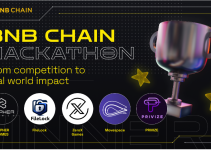
In the previous articles of the Project Spotlights series, where we’re interviewing projects developing on Binance Smart Chain, we shared with you the first three projects – ForTube, BurgerSwap, Bounce, Arkane Network, AnySwap, Bitquery, Blink, Tenderly, and Defistation. We continue with the Project Spotlights interviews, and the next project you’ll learn about is PARSIQ.
Please describe your project to those who might not be familiar with PARSIQ.
PARSIQ: PARSIQ is an IFTTT (If-This-Then-That) automation platform that makes blockchain events consumable and blockchain data actionable. It allows users – individuals, companies, enterprises—to monitor any events across different blockchains in real-time and at scale and connect those events to any off-chain apps or devices to automate different workflows.
PARSIQ is not only taking data from blockchains, it lives within them, speaks their languages natively, interconnects them, and allows anybody to get exact and timely information about any event that the user is eligible to listen or react to. We treat blockchains, not as a data store (like Google Big Query tries to do). We treat blockchains like they are live organisms with their streams, dynamics, flows and allowing users to react and we capture all these properties into our product.
Why did you decide to migrate/build on Binance Smart Chain?
PARSIQ: Not only does BSC have many technological advantages compared to other blockchains (more on that below), but BSC has an extremely high adoption rate as well as one of the richest ecosystems in terms of users, developer community, and projects building on the protocol. Both new and established players are building or migrating their solutions to the Binance Smart Chain and we believe we will see an even higher level of activity on BSC in the near-term as well as the long-term.
What do you see as the main advantage of BSC compared to other blockchains?
PARSIQ: The EVM compatibility is a truly smart move that will save project costs and time. Similarly, BSC’s consensus mechanism increases the performance of the blockchain which combined with the cost-effectiveness of the chain makes it far more lucrative than most blockchain protocols out there. Cross-chain functionality and wealth of different assets only further increase BSC’s value proposition.
How was the migration process? Can you name some of the highlights or positive experiences and, on the other hand, some of the challenges?
PARSIQ: Thus far, we are continuing with confidence. Our main priority is to patch the Binance Smart Chain client and introduce a set of plugins for various Event types that might be gathered based on the fundamental data circulating through the Node in the BSC network.
Since our past experience includes working with Ethereum Geth client – we have seen the similarity in angles. Because of this – our life was simplified and development costs were significantly lower to integrate with BSC.
Blockchain development itself set a new standard itself for proper documentation. Our development team is feeling really comfortable while working through the BSC documentation.
We also see a lot of extra interesting concepts besides Binance Smart Chain itself. For example, we are eager to work with Cross-Chain Contract events, like Transfer and Trade. That is why we have set our sights also on BSC Relayer and the Cross-Chain Mechanism after all.
It would be definitely a challenge to come up with a smart solution to allow monitoring and tracking activities from both Binance Chain and Binance Smart Chain.
PARSIQ is looking forward to conducting joint developer workshops and hackathons within the Binance ecosystem.
What kind of perks or benefits within the Binance ecosystem directly affect the performance and success of PARSIQ?
PARSIQ: For PARSIQ, in addition to funding and continuous support from Binance X, we can tap into the vibrant ecosystem around Binance to increase developer adoption (for developers to script BSC automation solutions via our own programming language ParsiQL), to attract projects to build on PARSIQ and attract users to monitor their favorite events on BSC.
Additionally, we see a strong opportunity to improve our platform to support a huge group of use cases under the Trading category via BSC.
What do you hope to see next from the BSC community?
PARSIQ: It is not an expectation per se, but we at PARSIQ just believe that every Blockchain client could internally (source code-wise) support some kind of a plugin system or API (at the source code level) for processing EVM operations so that external developers (like we at PARSIQ and many other projects building DApps) could have a better time developing specific monitoring solutions.
It would be a better approach to push-based monitoring. In this case, an internal to Node source code system of components (that is in response to listening to particular Blockchain Activities and forming Events) would also push Events further to a specified channel (i.e. RabbitMQ).
Where do you see DeFi and BSC in five years?
PARSIQ: The DeFi sector is still in its early experimental stage, but its success could be attributed to strong incentivization (rewards) for all contributors. Incentivizing all participants and a user experience (so-called one-click experience) that is easier and at times superior to a lot of traditional finance has to offer. By leveraging the properties of the Binance Smart Chain, DeFi projects can utilize BSC’s cross-chain asset functionality that we believe will push towards mass adoption in the long-term.
Did this interview inspire you to start building on BSC? We’re looking for new DeFi projects to join the ever-growing BSC ecosystem. Binance is prepared to help you with the transition, and support you both financially and technically. The ecosystem will help you grow, attract new users, and elevate your project to new heights.
If you’re interested in knowing more about the Binance incentives for BSC projects, please visit https://binancex.dev/index.html.
Alternatively, you can directly apply for the funding via this simple and straightforward form.


